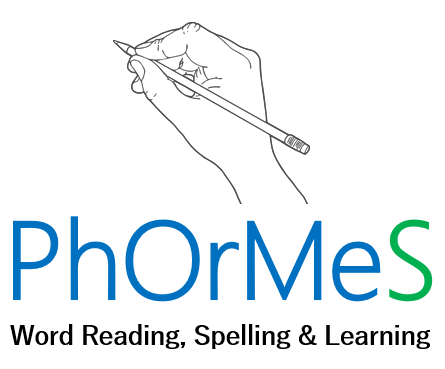Latin Morphology & etymology
-
Morphology is the study of morphemes. Morphemes are the smallest units of meanings in words. For example, the word dog has one morpheme. The word helpful has two morphemes (help-ful). The word reaction has three morphemes (re-act-ion).
Morphemes are typically either free or bound. Free morphemes are those that can stand alone and mean something (e.g. in the word, unclean, clean is a free morpheme because it means something by itself). Bound morphemes are those that attach themselves to free morphemes (e.g. in the word, reviewed, re- and -ed are bound morphemes because they do not exist alone but mean something when attached to a free morpheme, like view).
Free morphemes are often called base words and bound morphemes are typically affixes (prefixes and suffixes).
Morphology is an oral language component. However, morphemes are represented in English spelling too. English spelling represents speech sounds (e.g. jump), but it also represents morphemes (e.g. jumped, not jumpt). In this way, English is not a purely phonetic language in its spelling; it is morphophonemic.
Morphology is a fascinating component of language in English as it provides clues as to the meanings of words, reveals the history of where words in English come from and assists in spelling and reading development when taught explicitly.
-
Etymology is the study of word origins. The English language has a deep, complex and interesting history. English words come from many different languages due to historical events where the English language was influenced (and continues to be influenced) by foreign languages including French, Latin, Greek and Norse. The spelling of English words was equally influenced by these other languages.
Etymology goes hand in hand with morphology and orthography. English spelling appears to have many irregularities or exceptions. While there are some true irregularities, there is almost always reasons for the spelling of every English word. Etymology is generally able to explain these so called ‘irregularities’ (e.g. knight was once pronounced “k-n-ee-g-h-t” hence its modern spelling).
-
Short answer: yes.
Long answer: read below.
Firstly, we cannot possibly teach students at primary school level (or secondary level) everything about etymology and morphology. This is similar to phonics. However, this does not mean we should teach none of it, either.
There are three key reasons that justify why we should teach both morphology and etymology.
Vocabulary:
We know that the possession of a large vocabulary improves both reading comprehension and written expression. There are hundreds of thousands of words in English. Learning these words seems an impossible task until we realise that many words are related in meaning. Morphology and etymology underpin these relationships. An example of this is seen in the word, conceptualisation. What appears to be a very difficult word to learn on the surface becomes much easier to understand if its morphological family is studied. Related words include concept, concepts, conceptual, conceptualise, conceptualises, conceptualised and conceptualising. If students are able to take this word apart into its morphemes, they will have a good chance of understanding its meaning. Additionally, in learning how this word is put together, they will also learn all of the other words in the morphological family. Imagine students who can add masses of new vocabulary by simply learning one word. This is possible with morphology teaching. And also imagine if these same students were able to see the relationships between concept and intercept, receptor, inception, accepted and exceptional. This is possible with etymology teaching.
Teaching vocabulary explicitly and implicitly is important. However, additionally teaching morphology and etymology gives students an advantage in vocabulary learning as, together, they show students how similar words are related, how they can add many words to their vocabularies and how they can flexibly alter vocabulary in sentences using their morphological knowledge.
Spelling:
Phonics is important for spelling. However, learning and implementing phonics in spelling will only get students so far in the morphophonemic language that is English. While phonics has a very clear positive impact on the average population when it comes to spelling in years F-2, teaching of morphology has a larger positive influence on spelling development post year two. Teaching etymology is important here as much of advanced morphology teaching cannot occur without also teaching aspects of etymology.
The reasons for teaching morphology and etymology for spelling are quite clear. If a child needs to spell a word like yard, all they need is to know the sound-letter relationships y + ar + d and how to sequence those sound-letter relationships to spell the word correctly. However, if asked to spell unattractiveness, there is more needed that phonics. Knowing that the base word attract is made of at (towards) and tract (pull) will ensure we spell the word with two tts. Knowing the ive means ‘full of’ and is an adjective forming suffix is helpful. Knowing that un means not and that ness is a noun forming suffix is also important. And knowing how to spell each morpheme is important to reveal that the following letters unattractiveness (unstressed schwa vowels) are spelt the way they are.
Demystification of the English Spelling System:
In general society, and, sadly, in many schools, there is a belief that English spelling is so horribly disorganised that it borders on being impossible to teach. This is simply untrue.
In languages such as Greek or Italian, spelling is relatively simple in that it broadly represents how words sound. These languages have shallow orthographies. However, the English spelling system is opaque. In essence, this means that English spelling is deeply layered. English is a morphophonemic language. As such, it represents not only sound, but meaning too.
Teaching children phonics and spelling rules goes quite a way to revealing the English spelling system. In a shallow orthography like Finnish, phonics is all that is needed to show spelling patterns. However, these areas cannot explain all English spelling. Where these areas cannot explain how words are spelt, morphology and etymology can. In teaching these two language components, students gain increased confidence, motivation and persistence in learning English spelling as patterns slowly emerge in front of them.
Teaching morphology and etymology well to primary aged students affords them the opportunity to gain a deep appreciation of the complex, yet beautiful patterns of the English language.
-
Latin is now a dead language; however, it was the language spoken at the height of the Roman Empire. English is considered a Germanic language, so it is different from the modern romance languages that originated from Latin (i.e. French, Italian, Spanish, Portuguese & Romanian). However, Latin, via several avenues, interacted greatly with the English language. During these interactions, English borrowed mountains of words from this ancient language.
English borrowed so many words from Latin that this obsolete language is now represented in approximately 30% of English words.
Teaching the patterns of a set of words that govern 30% of English is essential to ensure children learn how to read and spell these words and adopt them into their vocabulary.
-
PhOrMeS teaches ‘Latin Morphology’ in two phases. Both phases are taught explicitly and at the whole class level.
Phase 1: Prefix & Suffix Learning
From Foundation to Year Three, students are taught the meanings of the most common prefixes and suffixes in English. While these affixes are not solely Latin, many are (e.g. bi, inter, ic, ous, ure, ment, ion and ive).
After learning the meanings of these prefixes and suffixes, students are taught to apply their meanings to words and to explain the meanings of words which contain the affixes that have been covered.
During explicit vocabulary section of PhOrMeS, each new word’s morphological family is referred to so that students see the links between vocabulary being taught and the other morphological aspects taught within PhOrMeS.
Phase 2: Latin Morphology & etymology Spelling Lessons
Latin Etymology is taught within spelling sessions starting in Year 3 and finishing at the end of Year 6.
Before starting these morphology/etymology-specific spelling lessons, students are taught a short history of English over three sessions to provide reasoning as to why they must learn about morphology and etymology.
In these specific spelling sessions, units are taught which revolve around a specific Latin base (e.g. port, leg, stru-struct, spec-spect-spic and vers-vert). Students review the meanings of prefixes and suffixes. They are taught to read, spell and learn words that come from the specific Latin base being studied using their knowledge of the morphological structure of the words.
After learning, reading and spelling words, students are asked to analyse and define words using their morphological, etymological and vocabulary knowledge. At later times, students are asked to complete sentences using the words being taught. They also practice changing sentences by using a different word in a morphological family (e.g. Our teacher gave us information about the excursion. Our teacher informed us about the excursion).
Each lesson is reviewed in an interleaving manner three times over a series of a month to ensure that students retain the information they have been taught.

